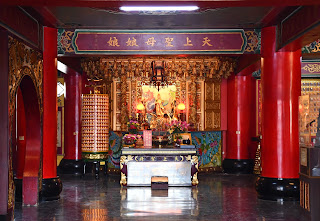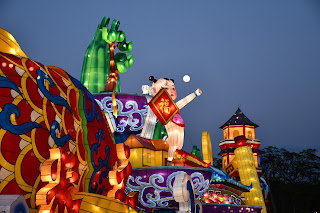Taichung
As other
Light fellows have been leaving China, some more frantically than others,
several have chosen Taiwan as their safe haven where they can keep on studying
Chinese while evading the novel coronavirus. Among them is my friend Zach, who
was vacationing in Hong Kong when it became evident that the situation was
worsening and his programme would have to be cancelled. I welcomed him in
Taipei the evening he arrived, and we went out to get hot pot together. I know
some other Yalies in my programme have been hesitating about seeing Zach,
seeing as he has just returned from across the strait, but as an avid reader of
Outlaws of the Marsh, I did not think it right to leave a friend hanging.
After taking a couple of pictures at Taichung Park – both with facemasks and without, of course – we scouted for food on our way to Taichung’s most iconic place of worship, Nantian Temple. That was, coincidentally, my first time accidentally getting stinky tofu with dried mackerel at a buffet, an unexpected curveball for a vegetarian.
Anyway, at
some point during the following week, Zach asked to borrow one of my textbooks
so that he might review before taking the entrance exam for my programme –
having left Hong Kong while on holiday, he had taken practically nothing to
Taiwan. As we were trying to figure out when he could come get it from me, we
both revealed that we were vaguely contemplating travelling to Taichung that
weekend for the long-advertised lantern festival of 2020. In a matter of
minutes, plans became reality and we were looking for transportation to
Taichung and accommodation there.
We left on
Saturday morning and headed straight to the Airbnb Zach found southeast of the
centre.
Once we jettisoned our unnecessary accoutrements, we set off into the
city along a rough route I sketched out in my guidebook. The first item on the
itinerary was the Taichung Prefectural Hall, originally built by the Japanese
in 1913 as the “Taichu Prefectural Hall.” From there, we wound our way through
various streets, passing by ornate temples and various shops to Taichung Park. We
saw crowds of people coursing in and out of the temples, which were all adorned
with various flowers and fruits – we figured that the lantern festival and the
date on the lunisolar calendar had to have something to do with it.
The Hotel Le Meridien standing behind an old building fusing neo-classical and Chinese features
Two more views of the juxtaposition of old and new
Taichu Prefectural Hall
Taichung Shiyakusho
Guanyin statue at a local temple
After taking a couple of pictures at Taichung Park – both with facemasks and without, of course – we scouted for food on our way to Taichung’s most iconic place of worship, Nantian Temple. That was, coincidentally, my first time accidentally getting stinky tofu with dried mackerel at a buffet, an unexpected curveball for a vegetarian.
Nantian Temple was truly a sight to behold, and well worth the dull twenty minutes we spent following the dry and dusty main road to get there. Intricately decorated and exuberantly ornate on every floor, the temple shocked us with a giant statue of Guanyu (familiar as the valiant warrior from the Romance of the Three Kingdoms), perched atop its roof.
Taichung Park
A rather aspirational epithet
The interior of Nantian Temple
The second floor of Nantian Temple
An idol at Nantian Temple
Another idol at Nantian Temple
Another idol at Nantian Temple
Another idol at Nantian Temple
Tablet and candle stands at Nantian Temple
A dragon pillar at Nantian Temple
A rabbit clearly stirring up trouble
The view of Taichung from Nantian Temple
A golden bull inside Nantian Temple
The exterior of Nantian Temple
A close-up of Guanyu atop Nantian Temple
From
Nantian, it was again a bit of a walk to our next destination, the Taichung
Martyrs’ Shrine and the directly adjoining Confucius Temple. We happened upon a
couple taking wedding photographs at the latter; this might have been my first
time seeing both bride and groom in traditional red, rather than the western
white gown and wedding suit. We finished our tour of the central part of the
city by dropping by the Buddhist Paochueh Temple, which was apparently just
being visited by a group of Japanese monks. They had presumably come to see the
small Japanese-built shrine to fallen soldiers, but the main attraction of
Paochueh is its giant golden Budai. We were surprised to find that circular
windows with swastikas covered the Budai’s back without any apparent pattern
whatsoever.
Was the restaurant themed after the dog or the dog after the restaurant? We may never know.
The Taichung Martyrs' Shrine
The main temple of the Taichung Martyrs' Shrine
The interior of the Taichung Martyrs' Shrine
A couple taking wedding photos at the Confucius Temple
The pillars of the Taichung Confucius Temple
The bride taking pictures showing off her veil
A Buddha idol riding atop a parked car
An interesting local house
An elephant at the Paochueh Temple
The old shrine at Paochueh protected by a new edifice built over its roof
A small reclining Budai at Paochueh Temple
The great golden Budai statue at Paochueh Temple
The back of the Budai
When we
exited the temple, finding transportation to our next destination suddenly posed
an unexpected difficulty. By public transport, it would have taken two hours to
get to the western part of the city, and all taxis near the temple compound
were apparently waiting for the people they had brought to return. Zach
eventually waved down a taxi at a nearby junction, powering through several
unsuccessful attempts without the least sign of disappointment.
In the
Western part of the city, we stopped by Wanhe Temple, built in 1726 and
dedicated to the Goddess Mazu. Right next door, we saw Wenchang Temple, which
is in turn dedicated to the god of learning. Judging by the number of visitors,
no exams are coming up anytime soon. The Mazu Temple, on the other hand, was so
packed one could hardly stay in one place without getting in another person’s
way.
The interior of Wanhe Temple
The goddess Mazu at Wanhe Temple
The back wall of Wanhe Temple
Golden Buddha statue at Wenchang Temple
The roof of Wanhe Temple
This time,
it was my turn to hail a cab, and I found one by directing us towards the main
road. We headed further westward to the Rainbow Village, a group of houses once
inhabited by KMT veterans. A soldier saved the compound from demolition by
covering its walls in bright colours and psychedelic figments of his
imagination. On our way out, we did not even need to look for a taxi, as one
taxi driver spotted us and did not have to persuade us long to ride his cab. He
was a very friendly man, and gave us plenty of tips on places to visit in
Taiwan. He drove us to Luce Memorial Chapel, an impressive modernist homage to
a Presbyterian missionary, and later to Houli, a northern district of Taichung.
A wall at Rainbow Village
Detail of one of the walls at Rainbow Village
A road by Luce Memorial Chapel
The side view of Luce Memorial Chapel
The back view of Luce Memorial Chapel
Houli was
in fact the centrepiece of our tour, for it was in Houli that the lantern
festival was to take place. When we arrived, the sky had not yet gone dark, but
crowds were filing out of busses and into the exhibition area. My descriptions
can’t quite do the exhibition justice, but hopefully these pictures will:






















































































Comments
Post a Comment